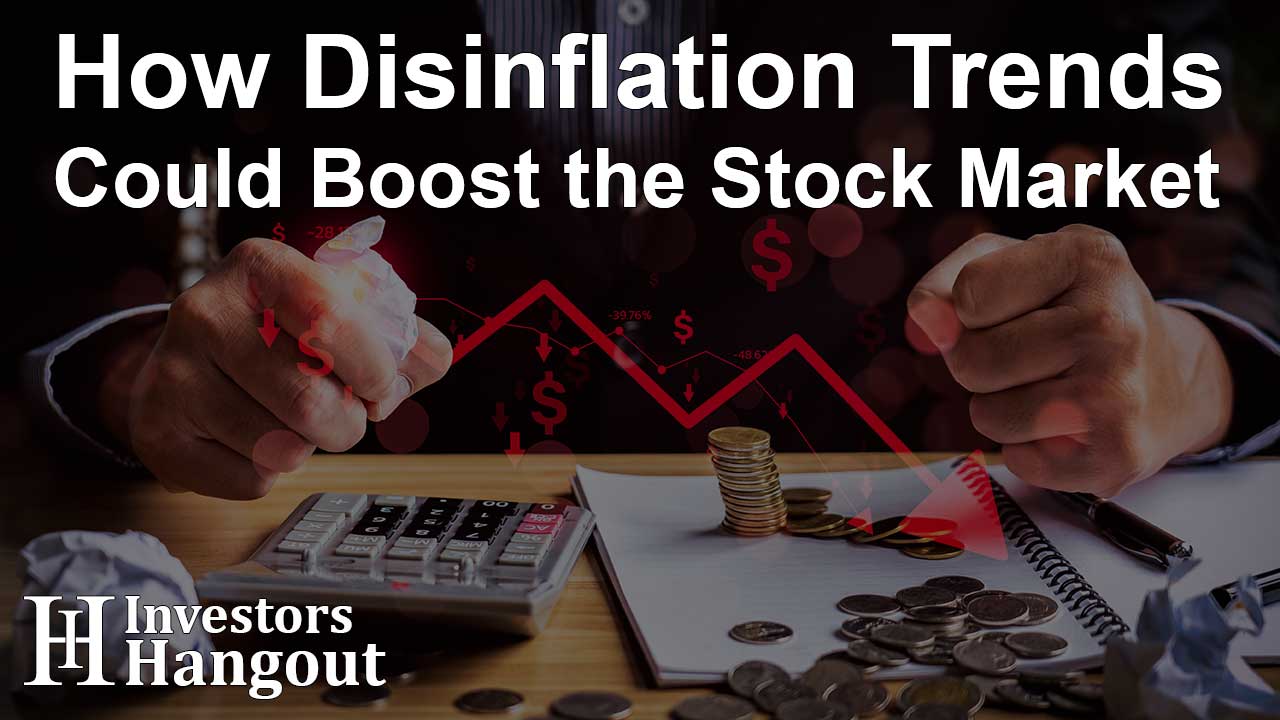How Disinflation Trends Could Boost the Stock Market

Reduced inflation rates and a stable economic climate brought about by disinflation can have a good effect on the stock market. It helps particular industries, consumer spending, and corporate profits; central banks are essential in controlling these trends. Disinflation does, however, carry hazards including possible deflation and strain on profit margins. To properly negotiate the market, investors should keep an eye on international issues and central bank policies.
Understanding Disinflation: A Primer
Slowing down of the rate of inflation is referred to as disinflation. It happens when prices are rising, albeit more slowly. Deflation, in which prices drop uniformly, is the opposite tendency. Sometimes after periods of high inflation, disinflation can indicate that the economy is becoming more stable. It implies that monetary policies of central banks work well to contain inflation. During a deflation, companies and consumers could feel more comfortable investing and spending. Knowing this idea facilitates the making of well-informed decisions by investors.
Current Disinflation Trends in 2024
Trends of disinflation are visible in a number of developed economies by 2024. Reducing inflation rates has been achieved by central banks without starting recessions. Stabilised commodity prices and increased supply chain efficiencies are two factors driving disinflation. Further slowed down inflation are production costs being lowered by technical developments. Governments contribute as well by carrying out wise fiscal measures. The economic climate is therefore getting better for investors. These patterns point to a possible growth in the stock markets.
The Impact of Disinflation on Corporate Profits
Profits of corporations can rise with disinflation. Lower input costs brought about by slowing inflation can help businesses increase their profit margins. More predictable business planning and investment can also result from stable prices. Higher spending consumers are probably going to boost sales. Higher earnings and revenues for businesses may follow from this. Many times, investors see disinflation as a positive indicator of the state of the economy. As so, their willingness to make stock investments might increase market performance.
Disinflation and Consumer Spending: A Positive Outlook
Consumer spending is benefited by disinflation since it keeps purchasing power constant. Slowly increasing prices give customers greater financial confidence. This assurance shows up as more money spent on products and services. Higher sales volumes are thus visible to retailers and service providers. Stable inflation rates also lessen the uncertainty that frequently undermines consumer spending. Long-term investments as well as short-term purchases are encouraged in this atmosphere. Disinflation can, all things considered, strengthen the economy by increasing consumer activity.
Interest Rates and Disinflation: A Symbiotic Relationship
Inflation and interest rates are intimately related. To control inflation, central banks frequently change interest rates. Cheaper borrowing made possible by lower rates can boost the economy. Raising rates, on the other hand, can help to cool down an economy that is too hot. Central banks might hold rates constant in a disinflationary setting to preserve economic stability. With this balance, long-term growth is supported without causing significant inflation. These rate decisions are closely watched by investors since they affect investment plans and the state of the market.
Sectoral Analysis: Winners in a Disinflationary Environment
A deflationary climate is favorable to some industries. As they offer necessary products and services, consumer staples and healthcare frequently do well. Companies in the technology industry gain as well from lower expenses and higher customer spending. With steady interest rates, financial services can expect higher margins. Further down the list of commodities-dependent industries is manufacturing. Investors looking to maximize their portfolios should note these profitable industries. To make wise investment choices, one must be aware of sectoral effects.
Historical Precedents: Learning from Past Disinflation Periods
Analyzing earlier periods of disinflation yields important information. History demonstrates that stock markets frequently do well during deflation. Consider the notable stock market gains of the early 1980s disinflationary era. Profits for companies increased when input costs leveled off. Higher investment and spending followed an improvement in consumer confidence. These trends imply that similar advantages may result from the disinflationary trends of today. History lessons enable investors to foresee changes in the market and plan appropriately.
Investment Strategies for a Disinflationary Market
Disinflation can be capitalized upon by investors using particular tactics. Key to diversified portfolios is to include industries that gain from steady pricing. Strong pricing power companies can also improve returns. Bonds could get more appealing as interest rates level off. Dividend-paying stocks should also be given some thought by investors seeking consistent income. Tracking economic data and central bank policies is essential. An informed and flexible investor can successfully negotiate a disinflationary market.
Risks and Considerations in a Disinflationary Economy
Disinflation entails certain hazards even with its advantages. Economically detrimental deflation can result from protracted disinflation. Too slow price increases could put pressure on profit margins for businesses. Should people anticipate further price declines, consumer spending may also stagnate. Aware of these possible traps should be investors. Riscons can be reduced by keeping a diversified and balanced portfolio. Sound investment decisions in a disinflationary economy need awareness of both opportunities and challenges.
Expert Opinions: Forecasts and Market Sentiments
Different experts project different things about disinflation and how it will affect markets. There are some analysts who think that stock market gains and steady economic growth will result from disinflation. Some warn that shocks from without could buck these patterns. Tracking the views of experts enables investors to determine the mood of the market. The advice of financial advisors is to keep up with world economic events. Many times, expert consensus indicates cautious optimism. This optimism should be balanced by caution and strategic planning on the part of investors.
Global Factors Influencing Disinflation Trends
Trends of disinflation are mostly shaped by global factors. By improving supply chain efficiency, international trade agreements can lower production costs. Supporting disinflation are stable commodity prices brought about by geopolitical stability. Automation and artificial intelligence, two examples of technological developments, reduce operating costs. Furthermore affecting home economies are international monetary policies meant to contain inflation. These elements acting together produce a climate that is favorable to disinflation. Global trends should be followed by investors to better comprehend possible effects on the market.
The Role of Central Banks in Managing Disinflation
The management of disinflation depends critically on central banks. They affect inflation with instruments of monetary policy, such asset purchases and interest rates. Central banks can either boost or slow down economic activity by adjusting interest rates. Purchases of assets provide the financial system liquidity, which promotes economic expansion. Central banks' communications also influence investor and market expectations. A steady disinflationary climate can be guaranteed by well-designed central bank policies. Investors monitor central bank activities intently to guide their strategies.
Long-Term Implications of Disinflation on the Economy
Economic consequences of disinflation are long-term. Because it stops uncontrollably high inflation, it can result in long-term economic stability and expansion. When inflation rates are lower, consumers' purchasing power increases and they spend consistently. Long-term planning and investment are made possible for businesses by predictable cost structures. Prolonged disinflation, however, runs the danger of turning into difficult-to-fight deflation. Economic stagnation must be avoided by policymakers balancing growth with disinflation. For investors and legislators alike, knowing these long-term consequences is essential.
Conclusion
Investors looking to take advantage of market opportunities must grasp and manage disinflation trends. Firm profits, consumer spending, and sectoral performance can all be improved by stable prices. Policies of central banks and other factors on a global scale greatly influence these tendencies. Disinflation carries hazards that need to be carefully considered even if it has advantages. Investors in a disinflationary climate can maximize their portfolios and achieve steady growth by being strategic and knowledgeable.
About The Author
Contact Olivia Taylor privately here. Or send an email with ATTN: Olivia Taylor as the subject to contact@investorshangout.com.
About Investors Hangout
Investors Hangout is a leading online stock forum for financial discussion and learning, offering a wide range of free tools and resources. It draws in traders of all levels, who exchange market knowledge, investigate trading tactics, and keep an eye on industry developments in real time. Featuring financial articles, stock message boards, quotes, charts, company profiles, and live news updates. Through cooperative learning and a wealth of informational resources, it helps users from novices creating their first portfolios to experts honing their techniques. Join Investors Hangout today: https://investorshangout.com/
